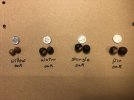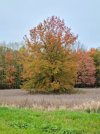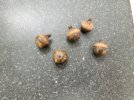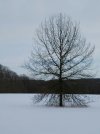Some of those leaves above look a lot like cherrybark. Did you mean 36" circumference? It doesn't appear to be 36" in diameter. Also there is a lot of hybridization in oak species, so there's that. Q. velutina (black oak) has large, light-colored, velvety terminal buds, so you might want to check for that.
-
If you are posting pictures, and they aren't posting in the correct orientation, please flush your browser cache and try again.
Edge
Safari/iOS
Chrome
You are using an out of date browser. It may not display this or other websites correctly.
You should upgrade or use an alternative browser.
You should upgrade or use an alternative browser.
Can U identify this oak tree please
- Thread starter Angus 1895
- Start date
Angus 1895
5 year old buck +
I might be right I will recheck
Angus 1895
5 year old buck +
Circumference is what I measured
Teeder
5 year old buck +
Bowsnbucks
5 year old buck +
I have a pin oak in my front yard. I planted it 36 years ago and the trunk was about the size of a shovel handle. Teeder's pic at post #26 shows pin oaks' natural growth habit of drooping lower limbs. If the tree in question doesn't have drooping lower limbs, it's probably not a pin oak. Momark made a valid point about oaks hybridizing among themselves too. Oaks are known for that.
The drooping limb trait is an identifying marker for pin oaks. If I hadn't pruned off the lower limbs up to about 15 ft. above the ground - I'd never be able to mow around it. Teeder's pic shows their natural growth habit.
The drooping limb trait is an identifying marker for pin oaks. If I hadn't pruned off the lower limbs up to about 15 ft. above the ground - I'd never be able to mow around it. Teeder's pic shows their natural growth habit.
BenA
5 year old buck +
Here's some info on the Scarlet Oak. It does tend to look similar to Black and Pin.
 dendro.cnre.vt.edu
dendro.cnre.vt.edu
Virginia Tech Dendrology Fact Sheet
Teeder
5 year old buck +
Here are a few acorns I collected from my pin this past fall. The caps are much tighter/smaller.
And to go along with the hybrid comment, this tree is 150 yards down wind from a wall of northern reds across the road. I'm hoping to get a hybrid out of the acorns I collected. Should be a cool tree.
And to go along with the hybrid comment, this tree is 150 yards down wind from a wall of northern reds across the road. I'm hoping to get a hybrid out of the acorns I collected. Should be a cool tree.
Attachments
BenA
5 year old buck +
Differences in Scarlet vs Pin Oaks found here: https://bplant.org/compare/174-178
Pin Oak vs Scarlet Oak
These plants are frequently confused, especially when used as landscaping plants, because both have deeply-cut leaves. Wild plants have almost opposite habitat preferences and rarely occur together. Pruning of landscaping plants can also make ID difficult by obscuring shape. Plants can be easily distinguished by acorns, and with more effort, by pubescence on buds and leaf shape.Pin Oak (Quercus palustris) | Scarlet Oak (Quercus coccinea) |
| A red oak of bottomland areas, with a large, heavy central trunk and abundant, small side branches. | A large, fast-growing, short-lived red oak of dry upland sites, named for the dark red color of its fall foliage. |
 Sinuses between lobes more U-shaped, with lobes usually not closing the curve as far. Lobe tips often pointing close to the same direction within each lobe. 5-7 lobes, 10-30 bristles/awns on lobe tips. Photo © Claire Secrist, Public Domain. | 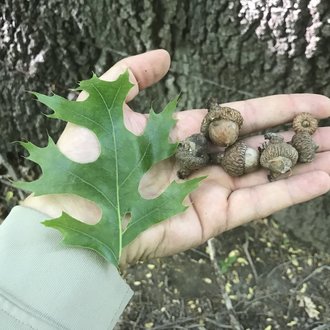 Sinuses between lobes more C-shaped, with lobes usually closing or completing more of a circle. Lobe tips curve away from each other more within each lobe. 5-9 lobes, 18-50 bristles/awns on lobe tips. Photo © Michael Ellis, CC BY 4.0. |
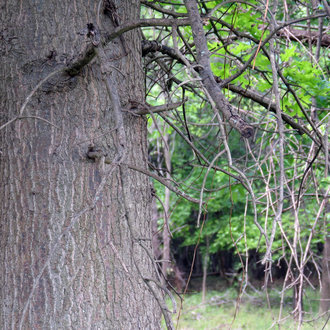 Lower branches strongly descending, middle branches horizontal, upper branches ascending. Slow to self-prune. Numerous small lower branches remain on trees after dying, often for years. Photo © Katja Schulz, CC BY 4.0. | 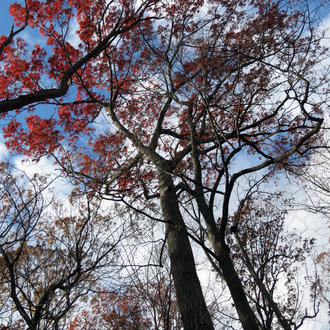 Self-prunes more readily, although it may retain larger dead branches. Trees in forests may have no branches until the canopy. When lower branches are present, not usually as strongly descending. Photo © Katja Schulz, CC BY 4.0. |
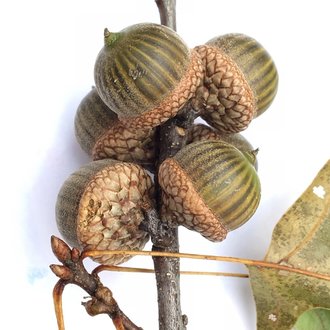 Very small acorns, 10-16 long and 9-15 mm wide, often look stout. Cap thin and saucer-shaped, only covers a small amount of the acorn. Photo © Ron Burkert, CC BY 4.0. | 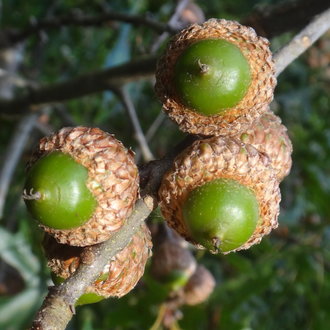 Acorns also small, 12-22mm long and 10-21 mm wide, often longer than wide. Cup-shaped cap covers about half the acorn and can be quite thick. Acorns have one or more rings of fine pits at the apex. Photo © Chris Kratzer, CC BY-SA 4.0. |
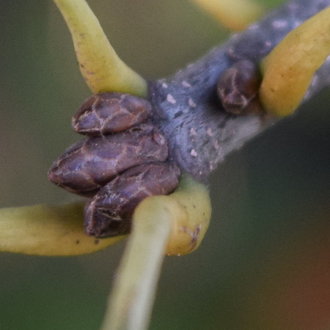 Buds average slightly smaller (3-5mm), reddish brown, hairless or with only a few fine hairs at the tip. Not as sharply angular. Photo © , CC BY-SA 4.0. |  Buds average slightly larger (4-7mm), variably pubescent, but usually pubescent at the tip and not at the base, and 5-angled in cross-section. Photo © Doug Goldman, CC BY 4.0. |
Angus 1895
5 year old buck +
I think it’s more like a scarlet or northern pin oak also but it is keeping the foliage over winter. But it is also young the leaves don’t look at all like cherry bark leaves
The bark and acorns look like scarlet the leaves look like a cross between scarlet and pin hopefully I can adjust my neutral to basic soil areas to accommodate the harvested acorns growth
The bark and acorns look like scarlet the leaves look like a cross between scarlet and pin hopefully I can adjust my neutral to basic soil areas to accommodate the harvested acorns growth
Angus 1895
5 year old buck +
Thanks to all of you for your help
Angus 1895
5 year old buck +
I should have some of these acorns to share I would love to trade for alkaline liking seeds
Angus 1895
5 year old buck +
After reviewing the scarlet oak, trees Seattle has in the past promoted/ sold these trees to the public.
so I am confident this is a scarlet oak, due to the nearly on inch acorns.
so I am confident this is a scarlet oak, due to the nearly on inch acorns.
Teeder
5 year old buck +
Here's a better picture of the drooping lower branches of the Pin.I have a pin oak in my front yard. I planted it 36 years ago and the trunk was about the size of a shovel handle. Teeder's pic at post #26 shows pin oaks' natural growth habit of drooping lower limbs. If the tree in question doesn't have drooping lower limbs, it's probably not a pin oak. Momark made a valid point about oaks hybridizing among themselves too. Oaks are known for that.
The drooping limb trait is an identifying marker for pin oaks. If I hadn't pruned off the lower limbs up to about 15 ft. above the ground - I'd never be able to mow around it. Teeder's pic shows their natural growth habit.
Attachments
Angus 1895
5 year old buck +
I think that the new leaf growth may be helpful in identifying, the scarlets new leaves should be red, then turn green.
Similar threads
- Replies
- 6
- Views
- 2K

